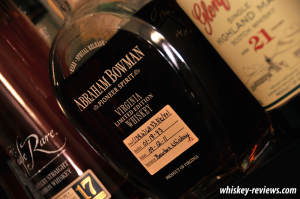 All whiskey novices step aside – this post is about the potency of the world’s greatest drink.
All whiskey novices step aside – this post is about the potency of the world’s greatest drink.
To the inexperienced, a high proof whiskey doesn’t taste like much more than alcohol. But, to the well-trained drinker, a high proof can mean exponentially more flavor than the standard 40 or 46 ABV.
When I talk about high proof whiskeys, I mean barrel proof (or cask strength) expressions such as George T. Stagg, Glenlivet Nàdurra, and Abraham Bowman. These whiskeys are taken straight out of the barrel keeping its natural alcohol content intact.
So what’s the difference between these whiskeys and something like Benchmark or Jack Daniel’s? Well, whiskeys like that are taken out of the barrel, and after several other processes, cut with water to reach the desired proof. This is totally fine and an accepted method – in fact most whiskeys follow this process. The issue with it is that water . . . well, waters down the whiskey and eliminates some of the flavor. So what may taste like pure rubbing alcohol in cask strength expressions actually has more whiskey flavor than the average drink.
I admit that I don’t always find myself drinking barrel proof whiskeys. First of all, they are often much more expensive largely because the distillers get less yield out of each barrel that way (do the math) but also because they typically bottle the higher quality barrels this way. It’s also not always easy to drink something that’s over sixty percent alcohol – if you’re responsible it can cut down your quantity of drinks in a night dramatically.
What’s your favorite cask-strength whiskey? Do you find that you get more flavor out of it, or does it burn the whole way down?
-Ryan

11 comments
1 pings
Skip to comment form
I agree with you it’s kindof a mixed bag. In an ideal world, my whisky would be the flavor bomb of a cask-strength but at about 47% ABV. I find that I can drink lower-proof cask-strength (such as Nadurra and Wild Turkey Rare Breed at 54%) fairly regularly, but once you start looking at 60% it gets to be so much you don’t want to wrestle with it that often, so I start debating purchasing those despite their great flavor.
Author
Nadurra is a good example of a cask-strength whisky that is relatively “easy” to drink by itself.
-Ryan
Your tongue wasn’t designed to drink cask strength whiskey. Not only does it burn, but it also numbs your taste buds and makes the flavors harder to discern.
That’s why most scotch is bottled at 43% ABV – when they decided on this, a couple hundred years ago, the majority of people agreed that it tasted the best at that level.
Author
Thanks for the comment, “Me”. Although I appreciate the comment, taste is something that is subjective – not everybody’s opinion will be the same. Although most Scotch is bottled at a tame alcohol level, it’s not always satisfying for all of us.
-Ryan
Some of my favorite cask strength offerings:
Potent Islay malts:
Port Charlotte PC6, PC7, PC8: bacon, iodine, salty smoke honey cereal sugar explosions
Laphroig Cask Strength: Sea and ash detonation
Sherry Bombs:
Aberlour A’bunadh
Glenfarclas 105
Bourbons:
Booker’s (the everyday bourbon bomb)
George T. Stagg Antiques (good luck finding any)
William Larue Weller Antique Collection (ditto)
Buffalo Trace Antique collection (ditto)
Parker Heritage
I like cask strength and I’ll take ’em neat (most of the time)…
Author
I haven’t had all of your recommendations, but I have had the pleasure of enjoying Booker’s, Stagg, and Weller. All excellent, barrel proof whiskeys that can be difficult to drink neat, but certainly rewarding!
-Ryan
Your point about flavor density is right on. You have to sip more slowly and take water more often, but cask strength offerings tend to have extraordinary depth of flavor.
The recent Jim Beam Devil’s Cut came about because they used a different water to cut down the whiskey. The emptied barrels were filled with water and agitated in the heat to “sweat” out the remaining bourbon trapped in the wood. This bourbon and water mix was then used to cut 6 year old Jim Beam bourbon to 45%.
I’d love to see a Scotch distillery try this.
Author
Very interesting, Eric. I was under the impression that Devil’s Cut was just a marketing term to explain the extra 5% ABV; had no idea there was an actual process behind it.
Thanks for the comment!
-Ryan
Chuck Cowdery mentions in one of his great blog posts that teens living near the bourbon distilleries would often “liberate” of the empty barrels and “sweat” out the trapped bourbon using this process. And yes they would drink this extremely watered down bourbon for the buzz. And apparently this practice was also occurring during Prohibition when the distilleries were making medicinal whiskey.
Now I wish I grew up in Kentucky near of the distilleries…
Author
“Free” bourbon – why not? 🙂
-Ryan
[…] wrote a post a little while back called “The Truth About Proof”, which (if you read it) would lead you to believe that more alcohol means more flavor. But, in […]